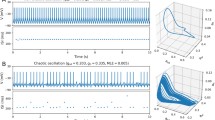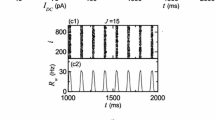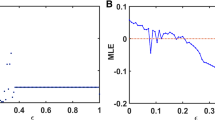Abstract
Chaotic dynamics have been evidenced in experimental data and numerical simulations ranging from the most straightforward individual neurons to the more complex neural groups. Nevertheless, whether chaotic behavior significantly contributes to the emergence of phase shift and spontaneous switchings between transient synchrony activities is subtle and remains elusive. We investigated the emergence of spontaneous transient synchrony activities and self-induced switchings in an excitatory-inhibitory network. We demonstrate that the dynamic nature of isolated neurons plays an essential role in the emergence of chaotic behavior, thereby affecting spontaneous transient synchrony and types of phase shift. We also show that the neural network of the cells with chaotic characteristics after synaptic interactions exhibits a broader range of excitatory transient synchronous dynamics. Our results offer several possibilities for explaining sensory perception and brain disease observed in experiments.








Similar content being viewed by others
Data Availability
All the data are available in the manuscript, or they will be provided on request.
References
Hopfield, J.J., Brody, C.D.: What is a moment? transient synchrony as a collective mechanism for spatiotemporal integration. Proc. Natl. Acad. Sci. 98(3), 1282–1287 (2001)
Rabinovich, M., Huerta, R., Laurent, G.: Transient dynamics for neural processing. Science 321(5885), 48–50 (2008)
Duarte, R., Seeholzer, A., Zilles, K., Morrison, A.: Synaptic patterning and the timescales of cortical dynamics. Curr. Opin. Neurobiol. 43, 156–165 (2017)
Palmigiano, A., Geisel, T., Wolf, F., Battaglia, D.: Flexible information routing by transient synchrony. Nat. Neurosci. 20(7), 1014–1022 (2017)
Khona, M., Fiete, I.R.: Attractor and integrator networks in the brain. Nat. Rev. Neurosci. 1–23 (2022)
Schirner, M., Xiaolu Kong, B.T., Yeo, T., Deco, G., Ritter, P.: Dynamic primitives of brain network interaction. Neuroimage 250, 118928 (2022)
Rabinovich, M.I., Varona, P., Selverston, A.I., Abarbanel, H.D.I.: Dynamical principles in neuroscience. Rev. Mod. Phys. 78(4), 1213 (2006)
Tang, G., Kesheng, X., Jiang, L.: Synchronization in a chaotic neural network with time delay depending on the spatial distance between neurons. Phys. Rev. E 84(4), 046207 (2011)
Kesheng, X., Maidana, J.P., Castro, S., Orio, P.: Synchronization transition in neuronal networks composed of chaotic or non-chaotic oscillators. Sci. Rep. 8(1), 8370 (2018)
Fan, H., Kong, L.-W., Wang, X., Hastings, A., Lai, Y.-C.: Synchronization within synchronization: transients and intermittency in ecological networks. Natl. Sci. Rev. 8(10), nwaa269 (2021)
Faure, P., Korn, H.: Is there chaos in the brain? i. concepts of nonlinear dynamics and methods of investigation. Comptes Rendus de l’Académie des Sciences-Series III-Sciences de la Vie 324(9), 773–793 (2001)
Korn, H., Faure, P.: Is there chaos in the brain? ii. Experimental evidence and related models. C. R. Biol. 326(9), 787–840 (2003)
O’Byrne, J., Jerbi, K.: How critical is brain criticality? Trends Neurosci. (2022)
Kesheng, X., Maidana, J.P., Caviedes, M., Quero, D., Aguirre, P., Orio, P.: Hyperpolarization-activated current induces period-doubling cascades and chaos in a cold thermoreceptor model. Front. Comput. Neurosci. 11, 12 (2017)
Pisarchik, A.N., Hramov, A.E.: Multistability in Physical and Living Systems. Springer, Berlin (2022)
Kesheng, X., Maidana, J.P., Orio, P.: Diversity of neuronal activity is provided by hybrid synapses. Nonlinear Dyn. 105, 2693–2710 (2021)
Zhou, X., Tian, C., Zhang, X., Zheng, M., Kesheng, X.: Short-term plasticity as a mechanism to regulate and retain multistability. Chaos Solitons Fractals 165, 112891 (2022)
Wang, X., Zhang, X., Zheng, M., Leijun, X., Kesheng, X.: Noise-induced coexisting firing patterns in hybrid-synaptic interacting networks. Physica A 615, 128591 (2023)
Hopfield, J.J.: Neurons with graded response have collective computational properties like those of two-state neurons. Proc. Natl. Acad. Sci. 81(10), 3088–3092 (1984)
Xie, X., Hahnloser, R.H.R., Sebastian Seung, H.: Double-ring network model of the head-direction system. Phys. Rev. E 66(4), 041902 (2002)
Wang, X.-J.: Probabilistic decision making by slow reverberation in cortical circuits. Neuron 36(5), 955–968 (2002)
Kesheng, X., Zhang, X., Wang, C., Liu, Z.: A simplified memory network model based on pattern formations. Sci. Rep. 4(1), 1–8 (2014)
Kesheng, X., Huang, W., Li, B., Dhamala, M., Liu, Z.: Controlling self-sustained spiking activity by adding or removing one network link. Europhys. Lett. 102(5), 50002 (2013)
Yao, Y., Yao, C.: Autapse-induced logical resonance in the Fitzhugh–Nagumo neuron. Nonlinear Dyn. 111(5), 4807–4821 (2023)
Yao, C., Xu, F., Tang, X., Zou, W., Yang, D., Shuai, J.: A physical understanding and quantification for the regulation of orexin on sleep. Chaos Interdiscip. J. Nonlinear Sci. 33(7) (2023)
Durstewitz, D., Deco, G.: Computational significance of transient dynamics in cortical networks. Eur. J. Neurosci. 27(1), 217–227 (2008)
Hastings, A., Abbott, K.C., Cuddington, K., Francis, T., Gellner, G., Lai, Y.-C., Morozov, A., Petrovskii, S., Scranton, K., Zeeman, M.L.: Transient phenomena in ecology. Science 361(6406), eaat6412 (2018)
Velez, A., Carlson, B.A.: Detection of transient synchrony across oscillating receptors by the central electrosensory system of mormyrid fish. Elife 5, e16851 (2016)
Shengdun, W., Zhou, K., Ai, Y., Zhou, G., Yao, D., Guo, D.: Induction and propagation of transient synchronous activity in neural networks endowed with short-term plasticity. Cogn. Neurodyn. 15, 53–64 (2021)
Wens, V., Bourguignon, M., Ghinst, M.V., Mary, A., Marty, B., Coquelet, N., Naeije, G., Peigneux, P., Goldman, S., De Tiège, X.: Synchrony, metastability, dynamic integration, and competition in the spontaneous functional connectivity of the human brain. Neuroimage 199, 313–324 (2019)
Morozov, A., Abbott, K., Cuddington, K., Francis, T., Gellner, G., Hastings, A., Lai, Y.-C., Petrovskii, S., Scranton, K., Zeeman, M.L.: Long transients in ecology: theory and applications. Phys. Life Rev. 32, 1–40 (2020)
Hastings, A.: Transients: the key to long-term ecological understanding? Trends Ecol. Evol. 19(1), 39–45 (2004)
Bogacz, R.: Optimal decision-making theories: linking neurobiology with behaviour. Trends Cogn. Sci. 11(3), 118–125 (2007)
Izhikevich, E.M.: Dynamical Systems in Neuroscience. MIT press, New York (2007)
McCann, K., Yodzis, P.: Nonlinear dynamics and population disappearances. Am. Nat. 144(5), 873–879 (1994)
Kuehn, C.: Multiple Time Scale Dynamics, vol. 191. Springer, Berlin (2015)
Reimer, J.R., Arroyo-Esquivel, J., Jiang, J., Scharf, H.R., Wolkovich, E.M., Zhu, K., Boettiger, C.: Noise can create or erase long transient dynamics. Thyroid Res. 14(4), 685–695 (2021)
Ohira, T., Milton, J.: Mathematics As a Laboratory Tool: Dynamics. Delays and Noise. Springer, Berlin (2021)
Poil, S.-S., Hardstone, R., Mansvelder, H.D., Linkenkaer-Hansen, K.: Critical-state dynamics of avalanches and oscillations jointly emerge from balanced excitation/inhibition in neuronal networks. J. Neurosci. 32(29), 9817–9823 (2012)
Deco, G., Kringelbach, M.L.: Metastability and coherence: extending the communication through coherence hypothesis using a whole-brain computational perspective. Trends Neurosci. 39(3), 125–135 (2016)
Dahmen, D., Grün, S., Diesmann, M., Helias, M.: Second type of criticality in the brain uncovers rich multiple-neuron dynamics. Proc. Natl. Acad. Sci. 116(26), 13051–13060 (2019)
Li, J., Shew, W.L.: Tuning network dynamics from criticality to an asynchronous state. PLoS Comput. Biol. 16(9), e1008268 (2020)
Nowotny, T., Rabinovich, M.I.: Dynamical origin of independent spiking and bursting activity in neural microcircuits. Phys. Rev. Lett. 98(12), 128106 (2007)
Buckley, C.L., Nowotny, T.: Multiscale model of an inhibitory network shows optimal properties near bifurcation. Phys. Rev. Lett. 106(23), 238109 (2011)
Nakatani, H., van Leeuwen, C.: Transient synchrony of distant brain areas and perceptual switching in ambiguous figures. Biol. Cybern. 94, 445–457 (2006)
Creaser, J., Ashwin, P., Tsaneva-Atanasova, K.: Sequential escapes and synchrony breaking for networks of bistable oscillatory nodes. SIAM J. Appl. Dyn. Syst. 19(4), 2829–2846 (2020)
Park, C., Worth, R.M., Rubchinsky, L.L.: Neural dynamics in parkinsonian brain: the boundary between synchronized and nonsynchronized dynamics. Phys. Rev. E 83(4), 042901 (2011)
Tinkhauser, G., Torrecillos, F., Pogosyan, A., Mostofi, A., Bange, M., Fischer, P., Tan, H., Hasegawa, H., Glaser, M., Muthuraman, M., et al.: The cumulative effect of transient synchrony states on motor performance in Parkinson’s disease. J. Neurosci. 40(7), 1571–1580 (2020)
Carr, M.F., Karlsson, M.P., Frank, L.M.: Transient slow gamma synchrony underlies hippocampal memory replay. Neuron 75(4), 700–713 (2012)
Xing, D., Shen, Y., Burns, S., Yeh, C.-I., Shapley, R., Li, W.: Stochastic generation of gamma-band activity in primary visual cortex of awake and anesthetized monkeys. J. Neurosci. 32(40), 13873–13880a (2012)
Orio, P., Gatica, M., Herzog, R., Maidana, J.P., Castro, S., Kesheng, X.: Chaos versus noise as drivers of multistability in neural networks. Chaos Interdiscip. J. Nonlinear Sci. 28(10), 106321 (2018)
Fell, J., Axmacher, N.: The role of phase synchronization in memory processes. Nat. Rev. Neurosci. 12(2), 105–118 (2011)
Ray, S., Maunsell, J.H.R.: Do gamma oscillations play a role in cerebral cortex? Trends Cogn. Sci. 19(2), 78–85 (2015)
Ray, S., Maunsell, J.H.R.: Differences in gamma frequencies across visual cortex restrict their possible use in computation. Neuron 67(5), 885–896 (2010)
Ed Bullmore, Sporns, O.: Complex brain networks: graph theoretical analysis of structural and functional systems. Nat. Rev. Neurosci. 10(3), 186–198 (2009)
Hansen, E.C.A., Battaglia, D., Spiegler, A., Deco, G., Jirsa, V.K.: Functional connectivity dynamics: modeling the switching behavior of the resting state. Neuroimage 105, 525–535 (2015)
Coombes, S., Wedgwood, K.C.A.: Neurodynamics: An Applied Mathematics Perspective, vol. 75. Springer, Berlin (2023)
Hindmarsh, J.L., Rose, R.M.: A model of neuronal bursting using three coupled first order differential equations. Proc. R. Soc. Lond. B 221(1222), 87–102 (1984)
Coombes, S., Bressloff, P.C.: Bursting: The Genesis of Rhythm in the Nervous System. World Scientific, Singapore (2005)
Alreja, A., Nemenman, I., Rozell, C.J.: Constrained brain volume in an efficient coding model explains the fraction of excitatory and inhibitory neurons in sensory cortices. PLoS Comput. Biol. 18(1), e1009642 (2022)
Marín, O.: Interneuron dysfunction in psychiatric disorders. Nat. Rev. Neurosci. 13(2), 107–120 (2012)
Marom, S., Shahaf, G.: Development, learning and memory in large random networks of cortical neurons: lessons beyond anatomy. Q. Rev. Biophys. 35(1), 63–87 (2002)
Sahara, S., Yanagawa, Y., O’Leary, D.D.M., Stevens, C.F.: The fraction of cortical gabaergic neurons is constant from near the start of cortical neurogenesis to adulthood. J. Neurosci. 32(14), 4755–4761 (2012)
Wonders, C.P., Anderson, S.A.: The origin and specification of cortical interneurons. Nat. Rev. Neurosci. 7(9), 687–696 (2006)
Liu, G.: Local structural balance and functional interaction of excitatory and inhibitory synapses in hippocampal dendrites. Nat. Neurosci. 7(4), 373–379 (2004)
Van Vreeswijk, C., Sompolinsky, H.: Chaos in neuronal networks with balanced excitatory and inhibitory activity. Science 274(5293), 1724–1726 (1996)
Moreau, A.W., Amar, M., Le Roux, N., Morel, N., Fossier, P.: Serotoninergic fine-tuning of the excitation-inhibition balance in rat visual cortical networks. Cereb. Cortex 20(2), 456–467 (2010)
Ebsch, C.L.: Excitatory-Inhibitory Balance, Imbalance, and Amplification In Cortical Network Models. University of Notre Dame, New York (2019)
Gerstner, W., Kistler, W.M., Naud, R., Paninski, L.: Neuronal Dynamics: From Single Neurons to Networks and Models of Cognition. Cambridge University Press, Cambridge (2014)
Destexhe, A., Rudolph-Lilith, M.: Neuronal Noise, vol. 8. Springer, Berlin (2012)
Zador, A.: Spikes: exploring the neural code. Science 277(5327), 772–773 (1997)
Koch, C., Segev, I.: Methods in Neuronal Modeling: From Ions to Networks. MIT press, New York (1998)
Sterratt, D., Graham, B., Gillies, A., Willshaw, D.: Principles of Computational Modelling in Neuroscience. Cambridge University Press, Cambridge (2011)
Kuramoto, Y.: Chemical Oscillations, Waves, and Turbulence. Courier Corporation, North Chelmsford (2003)
Bertolotti, E., Burioni, R., di Volo, M., Vezzani, A.: Synchronization and long-time memory in neural networks with inhibitory hubs and synaptic plasticity. Phys. Rev. E 95(1), 012308 (2017)
Golomb, D., Rinzel, J.: Dynamics of globally coupled inhibitory neurons with heterogeneity. Phys. Rev. E 48(6), 4810 (1993)
Mulansky, M., Kreuz, T.: Pyspike a python library for analyzing spike train synchrony. SoftwareX 5, 183–189 (2016)
Kreuz, T., Mulansky, M., Bozanic, N.: Spiky: a graphical user interface for monitoring spike train synchrony. J. Neurophysiol. 113(9), 3432–3445 (2015)
Brunel, N., Wang, X.-J.: What determines the frequency of fast network oscillations with irregular neural discharges? i. Synaptic dynamics and excitation-inhibition balance. J. Neurophysiol. 90(1), 415–430 (2003)
Ahmadian, Y., Miller, K.D.: What is the dynamical regime of cerebral cortex? Neuron 109(21), 3373–3391 (2021)
Zerlaut, Y., Zucca, S., Panzeri, S., Fellin, T.: The spectrum of asynchronous dynamics in spiking networks as a model for the diversity of non-rhythmic waking states in the neocortex. Cell Rep. 27(4), 1119–1132 (2019)
Devroye, L., Lugosi, G.: Combinatorial Methods in Density Estimation. Springer, Berlin (2001)
Gramacki, A.: Nonparametric Kernel Density Estimation and Its Computational Aspects, vol. 37. Springer, Berlin (2018)
Geisler, C., Brunel, N., Wang, X.-J.: Contributions of intrinsic membrane dynamics to fast network oscillations with irregular neuronal discharges. J. Neurophysiol. 94(6), 4344–4361 (2005)
Holden, A.V., Winlow, W., Haydon, P.G.: The induction of periodic and chaotic activity in a molluscan neurone. Biol. Cybern. 43(3), 169–173 (1982)
Aihara, K., Matsumoto, G.: Temporally coherent organization and instabilities in squid giant axons. J. Theor. Biol. 95(4), 697–720 (1982)
Makarenko, V., Llinás, R.: Experimentally determined chaotic phase synchronization in a neuronal system. Proc. Natl. Acad. Sci. 95(26), 15747–15752 (1998)
Abarbanel, H.D.I., Huerta, R., Rabinovich, M.I., Rulkov, N.F., Rowat, P.F., Selverston, A.I.: Synchronized action of synaptically coupled chaotic model neurons. Neural Comput. 8(8), 1567–1602 (1996)
Faure, P., Kaplan, D., Korn, H.: Synaptic efficacy and the transmission of complex firing patterns between neurons. J. Neurophysiol. 84(6), 3010–3025 (2000)
Crevier, D.W., Meister, M.: Synchronous period-doubling in flicker vision of salamander and man. J. Neurophysiol. 79(4), 1869–1878 (1998)
Fisahn, A., Pike, F.G., Buhl, E.H., Paulsen, O.: Cholinergic induction of network oscillations at 40 hz in the hippocampus in vitro. Nature 394(6689), 186–189 (1998)
Isaacson, J.S., Scanziani, M.: How inhibition shapes cortical activity. Neuron 72(2), 231–243 (2011)
Ansmann, G., Lehnertz, K., Feudel, U.: Self-induced switchings between multiple space-time patterns on complex networks of excitable units. Phys. Rev. X 6(1), 011030 (2016)
Nunes Machado, J., Selingardi Matias, F.: Phase bistability between anticipated and delayed synchronization in neuronal populations. Phys. Rev. E 102(3), 032412 (2020)
Battaglia, D., Witt, A., Wolf, F., Geisel, T.: Dynamic effective connectivity of inter-areal brain circuits. PLoS Comput. Biol. 8(3), e1002438 (2012)
Lumer, E.D., Friston, K.J., Rees, G.: Neural correlates of perceptual rivalry in the human brain. Science 280(5371), 1930–1934 (1998)
Freyer, F., Roberts, J.A., Becker, R., Robinson, P.A., Ritter, P., Breakspear, M.: Biophysical mechanisms of multistability in resting-state cortical rhythms. J. Neurosci. 31(17), 6353–6361 (2011)
Freyer, F., Aquino, K., Robinson, P.A., Ritter, P., Breakspear, M.: Bistability and non-gaussian fluctuations in spontaneous cortical activity. J. Neurosci. 29(26), 8512–8524 (2009)
Funding
This work was supported by National Natural Science Foundation of China (Grants Nos. 12165016, 12005079 and 12305043), the funding for the Scientific Research Startup of Jiangsu University, China (Grant Nos. 4111190017 and 4111710001), the Natural Science Foundation of Jiangsu Province, China (Grant No. BK20220511). M. Zheng. appreciates the support from the Jiangsu Specially-Appointed Professor Program.
Author information
Authors and Affiliations
Corresponding author
Ethics declarations
Conflict of interest
The authors declare that they have no conflict of interest.
Additional information
Publisher's Note
Springer Nature remains neutral with regard to jurisdictional claims in published maps and institutional affiliations.
Rights and permissions
Springer Nature or its licensor (e.g. a society or other partner) holds exclusive rights to this article under a publishing agreement with the author(s) or other rightsholder(s); author self-archiving of the accepted manuscript version of this article is solely governed by the terms of such publishing agreement and applicable law.
About this article
Cite this article
Zhu, G., Zhang, Y., Wu, J. et al. Chaos shapes transient synchrony activities and switchings in the excitatory-inhibitory networks. Nonlinear Dyn 112, 7555–7570 (2024). https://doi.org/10.1007/s11071-024-09471-5
Received:
Accepted:
Published:
Issue Date:
DOI: https://doi.org/10.1007/s11071-024-09471-5




